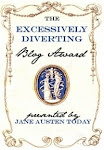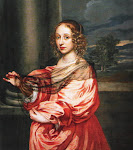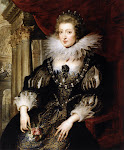
Much of the plot of Weave a Garland of my Vows revolves around the relationship of Marie de Rohan, Duchesse de Chevreuse and George Villiers, Duke of Buckingham.
In her latter years Marie was to confess that the only man she had ever truly loved was Buckingham. A fascinating relationship. For even their contemporaries knew that these two were never lovers.
As a writer of fiction it has been interesting for me to develop this intense, platonic relationship.
To my mind, Marie and George met themselves in each other. There were outward similarities in their respective positions in society – both of them were the much-loved favourite of a monarch. Although, unlike Buckingham, Marie’s blood was the deepest deep blue.
Personality-wise too, the similarities are striking. Both have been described as pleasant, facetious, affable, quick-tempered, generous, loyal and magnificent. Both were independent, outrageous and full of self-confidence.
And both had a startling ability to play extravagant practical jokes.
The following illustration of this fact is taken from Secret Anecdotes of the French Police – Memoires selected from the Archives of the Police of Paris, from the time of Louis XIV to the present day by J. Peuchet 1839
Peuchet says, ‘Now taking advantage of some isolated documents which I discovered in a pasteboard case which lay perdu behind one of the busts that adorn the Salle des Passports at the Prefecture of Police, I shall bring Cardinal Richelieu upon the stage in a more interesting and prominent manner.’
Those ‘isolated documents’ were reports made by Marquis de Beautru and Boisrobert, both creatures and spies of the Cardinal detailing certain activities surrounding the Queen, Anne of Austria in 1625.
“It is of general notoriety at the English Embassy that the duke is in love with the queen. He has even been presumptuous enough to have a portrait of that princess placed in his closet, under a canopy of blue velvet, surmounted by red and white plumes; and wears besides, a miniature of her majesty, encircled with large diamonds, suspended from his neck by a golden chain, as if it had been given him by the queen. He goes frequently to see the Duchesse de Chevreuse of whom he pretends to be enamoured, but she is in reality only his confidente....
Eight days ago the queen went to a collation at the hotel of the duchess. The king had promised to be present also, but the Duke of Buckingham was as unwilling to be obliged to follow in the suit of his most Christian majesty as he was to be absent on the occasion from his lady, the audacious name by which he calls the greatest princess in the world.
During this afternoon he appeared under five different disguises.
The first time he wore the Albert livery, and made one of the group of footmen in waiting for the arrival of the queen's carriage, and with an inconceivable temerity, it was he that let down the step of the carriage, thus usurping the functions of the officers of the crown ; and it is said that as her majesty stepped out of the carriage, he laid his hand tenderly on the royal foot.
The queen at first walked about the gardens, and the duke's next appearance was as one of a number of gardeners who came forward to offer fruits and flowers to our gracious sovereign. When it came to the duke's turn he dared to utter a compliment, but in so low a voice that no one but the queen heard him, and she was observed to blush.
Later in the day he presented himself in the costume of a magician оr fortune teller, and bу means of this disguise spoke twice to the queen. On the first of these occasions it was remarked that the duchess nudged the arm of the queen, as if to caution her majesty against being surprised ; and when the pretended astrologer approached, and appeared to be telling her her fortune, the princess became so confused, that the duchess made signs to the duke to warn him that he had gone too far. We know not, monsigneur, what sort of impertinence the duke allowed himself to utter at that moment.
The Duke of Buckingham then disguised with an appropriate mask, made his appearance and danced twice in the ballet of demons which was performed in that occasion; and lastly, in order to enable him tо remain a longer time near his lady that tasteful masquerade had been imagined, which drew forth the applause of your eminence and the king, that representing the visit made to the queen for the purpose of paying homage to her beauty and merit, the emperors of China, Japan, Abyssinia, of the Moguls, Mexico, and by the Sultan of Constantinople, the Sophy of Persia, the Grand Khan of Tartary, and the Inca of Peru, each escorted by a suite of masks.
It was known that the representatives of these sovereigns were all noblemen of the houses of Lorraine, of Rohan, of Bouillon, of Chabot, of Tremouille, &c. With the view of prolonging the duration of this gorgeous pageant, and the triumph of the queen, the above named potentates were invited to form part of their majesties' immediate circle.
The Grand Mogul who was to have been personated bу the young Duke de Guise, was in reality represented by the Duke of Buckingham, the former having consented for a loan of 3000 pistoles to let the latter take his place. The dress of the Duke of Buckingham was one blaze of jewels, and amongst them, to the astonishment of the whole court, sparkled the diamonds of the crown of England, which through an excess of foolish confidence, the King of Great Britain had allowed his favourite to bring away with him to France.
The young Duke of Guise attended the simulated Grand Mogul, as one of the lords of his suite, under the title of his sword bearer, so that aided by the Duchess of Chevreuse, the Duke of Buckingham might change dresses with him a moment before the king invited their pretended majesties to unmask and sup with him and the queen.
This shifting of dresses was effected by means of a closet, into which the Grand Mogul and his sword bearer retired, and as after supper they were to remask and recommence dancing, a new exchange of turbans and robes enabled the Duke of Buckingham to assume his former character. All this was managed by the charitable assistance of the Duchess de Chevreuse, so that during the entire of the entertainment the rash foreigner had frequent opportunities of conversing freely with his lady What did he not say to her?”
~
A nice little insight into the true nature of known characters.













 ~
~








